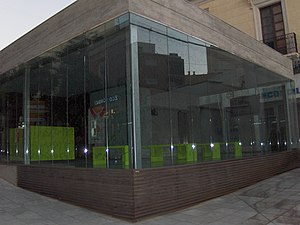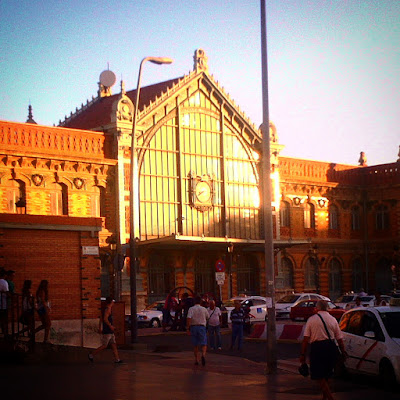Underground galleries, designed by the architect Guillermo Langle Rubio, in order to save human lives from the war. From the 4.5 km originally built, almost 1 km has been recovered, which coincides with the principal artery: The paseo de Almería. Its design started in 1936, and building began in 1937 and finished in 1938.
Langle thought of all kinds of details to enhance security in the shelters of people: Ventilation, placing outgoing inputs to avoid avalanches; and even surgery to assist the wounded. After the war, the entrances were closed with a rationalist kiosks which became part of the furniture of the city. some like the Urrutia Plaza, Plaza de Conde Otalia and Plaza Virgen del Mar. still remain.
 |
| https://indalow.files.wordpress.com/2011/11/plaza-virgen-del-mar.jpg |
They are today the most important and better preserved shelters in all Europe. These refuges have stood the most important attack in all Almería's history, the Bombardment of Almería, by the nazis in 1937. The zones used as pantry and kitchen have been recreated as well as the operating rooms, where all materials displayed are from the year 1941.
Address: Manuel Pérez García Square, 04001 Almeria.
Tel.: 950 268 696.
Email: refugios@aytoalmeria.es (Booking at a ticket office by telephone is essential; groups may book by email.)
Open: Tuesdays to Thursdays from 10 am to 2 p.m.; Fridays, Saturdays and Sundays from 10 am to 2 pm and from 5 pm to 9 pm.
 |
| https://upload.wikimedia.org/wikipedia/commons/thumb/3/3b/Entrada_refugios_Almer%C3%ADa.JPG/300px-Entrada_refugios_Almer%C3%ADa.JPG |
http://www.aytoalmeria.es/turismo http://www.turismodealmeria.org/es/motivo-tematico/spanish-civil-war-bomb-shelters_163
http://www.polibeaturismo.com/boletinesAnteriores/2007/enero/noticia4_en.htm
http://www.guiarepsol.com/en/tourism/museums/70815-refugios-de-la-guerra-civil-espanola/
https://en.m.wikipedia.org/wiki/Almer%C3%ADa_air_raid_shelters



























